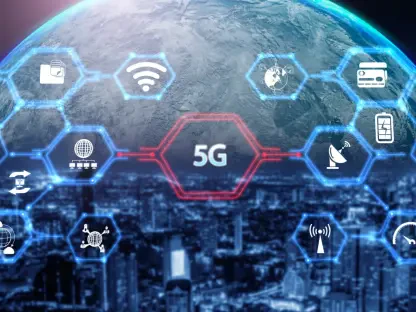The global optical cable market is on the cusp of a significant expansion, with projections indicating growth from $12.18 billion in 2023 to an impressive $27.12 billion by 2033, advancing at a Compound Annual Growth Rate (CAGR) of 8.33%. This predicted leap can be attributed to the surging demand for fiber optic technology, which is crucial for improving data transmission speeds and supporting the rapid increase in bandwidth needs.As the world shifts more towards digital operations, fiber optics are becoming the backbone of modern data infrastructure. The rising digitization of industries and the deep integration of the Internet of Things (IoT) into daily operations are fueling this heavy reliance on robust fiber optic networks. This reliance is expected to drive the optical cable market to new levels of growth and effectiveness, catering to the escalating data transmission requirements in our increasingly connected world. As we move further into the digital age, the optical cable market is thus poised to become a vital player in the technology landscape, accommodating the world’s growing need for high-speed, large-scale data connectivity.
The Driving Forces Behind the Market Growth
Unraveling the reasons behind the optical cable market’s stride reveals a complex interplay of technological demands and industry adaptations. The pivot towards fiber optic technology has been largely because of its unparalleled data transmission capabilities and minimal loss, presenting key industries with the gift of speed and efficiency. Healthcare stands as a prime example where timely and reliable data handling is not just a benefit, but a necessity. Moreover, the increasing penetration of IoT devices accentuates the need for robust backbones that can manage heavy data loads, thereby pushing for wider deployment of optical cables. As consumers grow more voracious in their data consumption and as businesses become more data-centric, this technology is becoming less of a choice and more of a mandate for progress. Not to mention the ever-escalating demands for higher bandwidth required to sustain the upsurge in online services and cloud computing networks, the optical cable market’s upward trajectory seems unshakable.
Regional Market Analysis: Asia Pacific vs. North America
A geographical lens on the market’s expansion points to the Asia Pacific leading the charge, with China solidifying its status as a juggernaut in the optical cable domain. China’s deliberate steps towards incorporating fiber optics across various infrastructures, from bustling smart cities to streamlined data centers, outline the commitment that underpins its market share. The extensive state-led initiatives to modernize connectivity infrastructure endow the region with a competitive edge. Alternatively, the North American market, with the US at the forefront, projects the highest growth rate, propelled by its swift embrace of high-speed internet solutions. The region’s receptiveness to cutting-edge technology in sectors such as defense, healthcare, and IT is creating extensive opportunities for optical cable providers, further fueled by government policies that back digital infrastructure development.
Glass Segment and Single-Mode Optical Cables: Leading the Market
The supremacy of the glass optical cables lies in their inherent ability to transmit light with minimal signal loss over large distances, which translates into an efficacious and reliable means of communication. It is this capacity that ensures its command over the market throughout the forecast period. Concurrently, single-mode optical cables are expected to garner the most significant market share against their multi-mode counterparts. Owing to their proficiency in delivering high-speed data over considerable distances without substantial signal degradation, single-mode cables capitalize on the growing demand for long-haul data transmission, finding favor particularly among telecommunication providers and internet service organizations that require deep-seated network reliability and performance.
Telecom and Networking: The Forerunners in End-User Segments
The telecommunications and networking industries are at the forefront of the fiber optic market, driven by the unyielding demand for faster, more reliable data transmission. Fiber optics have become indispensable for their ability to handle massive data loads with unfaltering dependability, especially as mobile broadband, video streaming, and cloud computing continue to increase data traffic globally. As a cornerstone of communication networks, optical cables are critical for this data exchange.Additionally, sectors like healthcare and defense are increasingly relying on fiber optics. These sectors require communication systems that are secure and resistant to electromagnetic interference—a niche perfectly suited for fiber optics. Healthcare’s increasing reliance on telemedicine and digital records, along with the defense industry’s need for secure communications, means these sectors prioritize the consistency and security offered by fiber optic technology.Thus, as our world grows more interconnected and our reliance on digital technologies expands, the use of optical cables is likely to surge. The fiber optic network serves as the lifeline of modern communication, carrying the promise of seamless connectivity and high-speed data transfer, part and parcel of an increasingly digitized society’s infrastructure.
Corporate Initiatives and Market Strategies
The crescendo in market demand has not gone unnoticed by key industry players such as General Cable Corporation and Corning Inc. These corporations are deeply entrenched in the ethos of innovation, investing heavily in R&D to create conduits capable of handling future data requirements. As competition intensifies, strategic partnerships and market consolidations are becoming more commonplace, acting as a catalyst for growth. By engaging in such alliances, companies enhance their portfolios, broaden their market footholds, and offer more technologically advanced solutions. This strategy ensures that, despite high upfront investments and the looming presence of wireless alternatives, the optical cable market is on a steadfast path to substantial growth and enduring relevancy in the digital infrastructure landscape.









